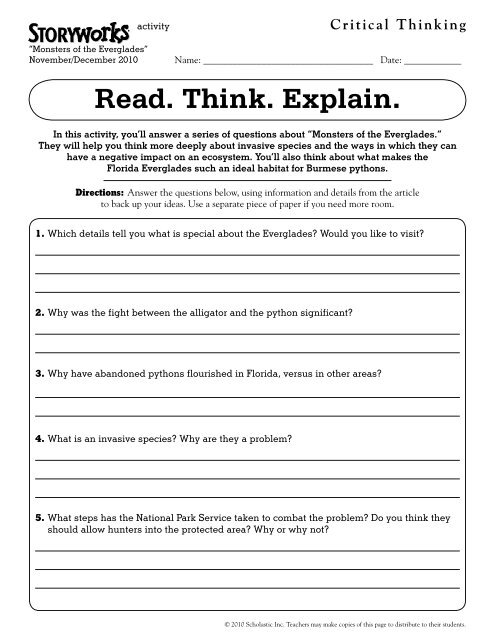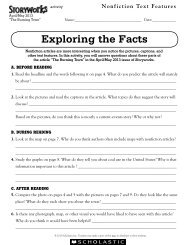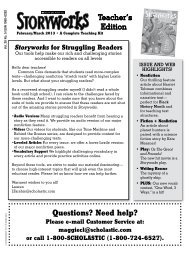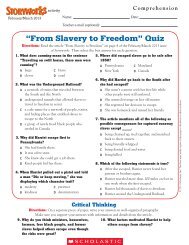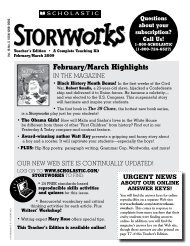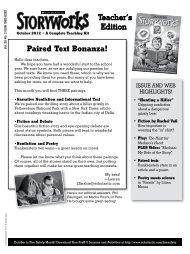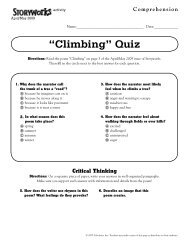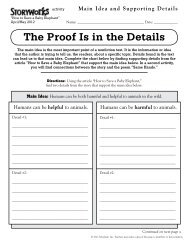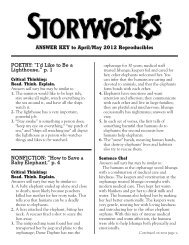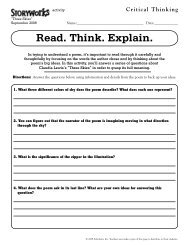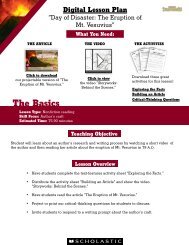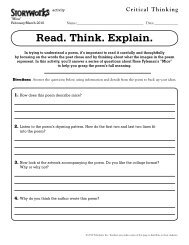Here - Scholastic
Here - Scholastic
Here - Scholastic
You also want an ePaper? Increase the reach of your titles
YUMPU automatically turns print PDFs into web optimized ePapers that Google loves.
“Monsters of the Everglades”<br />
November/December 2010<br />
activity<br />
Critical Thinking<br />
Name: ___________________________________ Date: ____________<br />
Read. Think. Explain.<br />
In this activity, you’ll answer a series of questions about “Monsters of the Everglades.”<br />
They will help you think more deeply about invasive species and the ways in which they can<br />
have a negative impact on an ecosystem. You’ll also think about what makes the<br />
Florida Everglades such an ideal habitat for Burmese pythons.<br />
Directions: Answer the questions below, using information and details from the article<br />
to back up your ideas. Use a separate piece of paper if you need more room.<br />
1. Which details tell you what is special about the Everglades? Would you like to visit?<br />
2. Why was the fight between the alligator and the python significant?<br />
3. Why have abandoned pythons flourished in Florida, versus in other areas?<br />
4. What is an invasive species? Why are they a problem?<br />
5. What steps has the National Park Service taken to combat the problem? Do you think they<br />
should allow hunters into the protected area? Why or why not?<br />
© 2010 <strong>Scholastic</strong> Inc. Teachers may make copies of this page to distribute to their students.
“Monsters of the Everglades”<br />
November/December 2010<br />
Sentence 1:<br />
Sentence 2:<br />
Sentence 3:<br />
Sentence 4:<br />
activity<br />
Vocabulary<br />
Name:____________________________________ Date:_____________<br />
Vocabulary Monster<br />
This issue’s nonfiction article, “Monsters of the Everglades,” includes some amazing<br />
(and maybe a little bit scary) words. In this activity, you will use a dictionary to match<br />
the words below to their definitions.<br />
Directions: Match each word on the left to its definition on the right.<br />
Then choose four of the words and write a sentence using each one.<br />
aggressive having great power, dignity, and beauty<br />
grave very serious<br />
gruesome brought into a country from elsewhere<br />
horrifying disgusting and horrible<br />
imported state of being full of insect or animal pests<br />
infestation like a reptile, such as a lizard or snake<br />
majestic forceful, bold, or eager to fight<br />
reptilian shocking and scary<br />
© 2010 <strong>Scholastic</strong> Inc. Teachers may make copies of this page to distribute to their students.
“Monsters of the Everglades”<br />
November/December 2010<br />
activity<br />
Cause/Effect<br />
Name:____________________________________ Date:_____________<br />
Ask What, Ask Why<br />
You eat three bowls of pasta. What happens? You get a stomachache. You ace your piano recital.<br />
Why? You practiced every day. It’s easy to figure out cause-and-effect relationships by asking<br />
two simple questions: “What happened?” (to find an effect) and “Why did this happen?” (to find<br />
a cause). Try it out to find the cause-and-effect relationships in “Monsters of the Everglades.”<br />
Directions: Fill in what’s missing from each cause-and-effect pair. Use the hints to help you.<br />
1. CAUSE:<br />
EFFECT: Many people bought Burmese pythons from pet stores in the early 1990s.<br />
HINT: What three reasons make Burmese pythons such a popular choice for a pet?<br />
2. CAUSE: Burmese pythons have a huge appetite.<br />
EFFECT:<br />
HINT: How long is a Burmese python?<br />
3. CAUSE:<br />
EFFECT: Regretful pet owners set their unwanted snakes loose in the wild.<br />
HINT: What are some reasons pythons are difficult to keep as pets?<br />
4. CAUSE: Florida’s Everglades National Park has a semitropical climate with lots of salty rivers and woods.<br />
EFFECT:<br />
HINT: What kind of environment do Burmese pythons thrive in?<br />
5. CAUSE: The Burmese python population in the Everglades is out of control.<br />
EFFECT:<br />
HINT: What has the National Park Service done to slow down the snake invasion?<br />
6. CAUSE:<br />
EFFECT: A full-grown python is king (or queen) of the Everglades.<br />
HINT: What are some ways that the python has control over other animals, birds, and reptiles in the park?<br />
7. CAUSE:<br />
EFFECT:<br />
8. CAUSE:<br />
EFFECT:<br />
Now, on your own, find two cause-and-effect relationships from the article.<br />
© 2010 <strong>Scholastic</strong> Inc. Teachers may make copies of this page to distribute to their students.
“Monsters of the Everglades”<br />
November/December 2010<br />
Try this<br />
with a<br />
partner!<br />
activity<br />
Research Skills<br />
Name: ______________________________ Date: _____________<br />
Find Out More<br />
Nonfiction writing teaches you something new. But a good article may also inspire you<br />
to learn more about what you read. “Monsters of the Everglades” introduced a lot of<br />
interesting science topics. Now it’s your turn to find out more! In this activity, you will<br />
research a topic related to “Monsters of the Everglades.”<br />
Directions: Choose a topic related to the nonfiction article to research. You can research the Everglades<br />
ecosystem, Burmese pythons, the exotic pet trade, or invasive species. Then use the article, dictionaries,<br />
encyclopedias, other nonfiction articles or books, or Web resources to learn more about it.<br />
STEP 1: Identify your topic.<br />
What do you want to research? ___________________________________________________________<br />
STEP 2: Gather what you already know.<br />
Look at the article again. Write down three or more facts from the article about your topic.<br />
______________________________________________________________________________________<br />
______________________________________________________________________________________<br />
______________________________________________________________________________________<br />
______________________________________________________________________________________<br />
STEP 3: Think of the questions you want to ask.<br />
Before you start your research, it helps to write a list of questions that you want to answer. You can choose<br />
words to look up, facts you’d like to know about plants or animals, historical information about places or<br />
people, or you could write questions about more recent events.<br />
1. ____________________________________________________________________________________<br />
2. ____________________________________________________________________________________<br />
3. ____________________________________________________________________________________<br />
4. ____________________________________________________________________________________<br />
5. ____________________________________________________________________________________<br />
Continued8<br />
© 2010 <strong>Scholastic</strong> Inc. Teachers may make copies of this page to distribute to their students.
“Monsters of the Everglades”<br />
November/December 2010<br />
activity<br />
Find Out More, continued<br />
STEP 4: Identify your research resources.<br />
On Your Own<br />
Write a list of five more questions about<br />
your topic. Then describe how you would find<br />
the answers.<br />
Research Skills<br />
Now that you have your questions, figure out what tools you can use to find the answers. <strong>Here</strong> are a few<br />
research tools you might have in your classroom or library. You could also use other nonfiction books or<br />
articles you find in your classroom, library, or at home.<br />
Dictionaries: Find definitions of words you don’t know.<br />
Encyclopedias: Find basic information about people, places, plants, and animals.<br />
Atlases: Find maps and other geographical information.<br />
Web resources: Find a wide variety of resources and more in-depth information online. For this project, you<br />
might want to start at the Everglades page of the National Parks Service Web site: www.nps.gov/ever/<br />
STEP 5: Using your resources, answer your questions.<br />
Start finding answers! If you need help using any of the resources, ask your teacher or librarian.<br />
1. ______________________________________________________________________________________<br />
________________________________________________________________________________________<br />
2. ______________________________________________________________________________________<br />
________________________________________________________________________________________<br />
3. ______________________________________________________________________________________<br />
________________________________________________________________________________________<br />
4. ______________________________________________________________________________________<br />
________________________________________________________________________________________<br />
5. _____________________________________________________________________________________<br />
________________________________________________________________________________________<br />
With a Partner<br />
Using the information you found in your<br />
research, write a paragraph about your topic.
“Porlock”<br />
November/December 2010<br />
activity<br />
Critical Thinking<br />
Name: ___________________________________ Date: ____________<br />
Read. Think. Explain.<br />
An active reader always looks for deeper meaning in a story. In this activity, you’ll answer<br />
questions about Nick and Darla, the main characters in Lisa Graff’s endearing story.<br />
You’ll also think about how these siblings work together to solve their problems.<br />
Directions: Answer the questions below, using information and details from the story<br />
to back up your ideas. Use a separate piece of paper if you need more room.<br />
1. How does Nick view Darla in the beginning of the story?<br />
2. What details show what Darla is like?<br />
3. How does Porlock’s eating the palace change the way Nick and Darla treat each other?<br />
4. Nick and Darla start out with separate problems. What is their common solution?<br />
© 2010 <strong>Scholastic</strong> Inc. Teachers may make copies of this page to distribute to their students.
“Porlock”<br />
November/December 2010<br />
Try this<br />
with a<br />
partner!<br />
1<br />
activity<br />
Identifying Plot Points<br />
Name: ___________________________________ Date: ____________<br />
Building Blocks of Plot<br />
Every story is different. But most stories follow a similar pattern. First, we learn about the<br />
characters’ main problem. Then the plot thickens (we call that the rising action), and<br />
the problem gets more complicated. Then the climax of the story happens. And then<br />
(whew!), the falling action: The problem gets resolved. Finally, there’s a conclusion.<br />
These different parts of the plot are known as “plot points.”<br />
Directions: Each block in the pyramid is one part of the plot of “Porlock.” In each block, write the answer to<br />
the question, using the options listed on page 2. When you’re done, you’ll see the main plot points of the story.<br />
2<br />
Rising Action<br />
How does the problem<br />
get more complex?<br />
1<br />
Opening Incident<br />
What’s the main<br />
problem?<br />
3<br />
Climax<br />
How does the problem<br />
reach a peak?<br />
2<br />
3<br />
4<br />
Falling Action<br />
How does the<br />
problem get solved?<br />
© 2010 <strong>Scholastic</strong> Inc. Teachers may make copies of this page to distribute to their students.<br />
4<br />
5<br />
Conclusion<br />
What happens<br />
at the very<br />
end?<br />
5
“Porlock”<br />
November/December 2010<br />
activity<br />
Directions: Place each plot point in the appropriate box on page 1.<br />
(Note: Some boxes will contain more than one plot point.)<br />
Darla gets a good grade on her diorama.<br />
Nick and Darla work together to rebuild the palace and make a home for Porlock.<br />
Porlock is missing, and Nick blames Darla.<br />
Darla tries to build the palace.<br />
Porlock is an emperor.<br />
Nick and Darla get along.<br />
Porlock destroys the palace, and Darla laughs.<br />
Nick searches for and fixes up the aquarium.<br />
Identifying Plot Points<br />
Building Blocks of Plot, continued
activity<br />
The Voyage of the Dawn Treader<br />
November/December 2010<br />
Critical Thinking<br />
Name: ___________________________________ Date: ____________<br />
Read. Think. Explain.<br />
The third book in C.S. Lewis’s ever-popular Chronicles of Narnia series is a new movie! In this<br />
activity, you’ll answer questions about important plot points in our play adaptation. You’ll also think<br />
about the choices certain characters make and how these decisions influence plot development.<br />
Directions: Answer the questions below, using information and details from the play to back up your ideas.<br />
1. What news does Lord Bern deliver? How does it start the Dawn Treader’s voyage?<br />
2. What does the magician tell them about the mist? How does Lord Bern’s message<br />
foreshadow what they learn from the magician?<br />
3. What risks do Edmund, Lucy, and the others take to collect the swords? Why do you think<br />
they take them?<br />
4. How does Eustace change from the beginning to the end of the play?<br />
5. How do you think the story will end?<br />
© 2010 <strong>Scholastic</strong> Inc. Teachers may make copies of this page to distribute to their students.
activity<br />
The Voyage of the Dawn Treader<br />
November/December 2010<br />
Genre Study<br />
Name:______________________________ Date:_____________<br />
What Makes a Fantasy?<br />
The Chronicles of Narnia are works of fantasy. But what does that mean? Fantasy is a genre—a<br />
category of books with similar features, stories, or characters. Each fantasy story is different, but<br />
some elements often reappear. In this activity, you’ll find examples of four elements of the fantasy<br />
genre from the play version of The Chronicles of Narnia: The Voyage of the Dawn Treader.<br />
Directions: Read The Voyage of the Dawn Treader and fill in the boxes with examples from the play of each of the<br />
elements of fantasy listed below.<br />
1. The story is set is a fictional world, often<br />
where supernatural events occur.<br />
3. Imaginary creatures exist.<br />
2. Some characters have magical powers.<br />
4. A conflict between good and evil is central<br />
to the plot, and it often involves a voyage<br />
and/or a battle.<br />
Critical Thinking<br />
Think of another example of the fantasy genre, such as a book you’ve read or a movie you’ve seen.<br />
Make a list of the fantasy elements from that story.<br />
© 2010 <strong>Scholastic</strong> Inc. Teachers may make copies of this page to distribute to their students.
“To the Thawing Wind”<br />
November/December 2010<br />
activity<br />
Critical Thinking<br />
Name:____________________________________ Date:_____________<br />
Read. Think. Explain.<br />
In trying to understand a poem, it’s important to read it carefully and thoughtfully<br />
by focusing on the words the poet chose and by thinking about what the images in the poem<br />
represent. In this activity, you’ll answer questions about Robert Frost’s<br />
“To the Thawing Wind” to help you grasp the poem’s full meaning.<br />
Directions: Answer the questions below, using information and details from the poem to back up your ideas.<br />
1. What is the main thing the poet wants the wind to do?<br />
2. What can you infer from the last line?<br />
3. How do you feel when winter keeps you inside?<br />
© 2010 <strong>Scholastic</strong> Inc. Teachers may make copies of this page to distribute to their students.
“To the Thawing Wind”<br />
November/December 2010<br />
activity<br />
Decoding Poetry<br />
Name:____________________________________ Date:_____________<br />
A Poet’s Plea<br />
Robert Frost’s poem “To the Thawing Wind” seems like a tough poem to understand, but it<br />
describes an experience that lots of people already know: wanting winter to end so you can<br />
go outside. In this activity, you will go through each section of the poem, figuring out what the<br />
words mean and how they describe a poet who’s had enough of the wintry weather.<br />
Do this<br />
with a<br />
partner!<br />
Directions: Read each section from “To the Thawing Wind.” Answer the questions to help you<br />
think about what each line means individually. Then think about the main idea of the section<br />
and how it fits with the rest of the poem.<br />
I. Come with rain, O loud Southwester!<br />
Bring the singer, bring the nester;<br />
1. A Southwester is a wind that comes from the Southwest. What does the poet want to have happen in the<br />
first line?<br />
2. What sings and builds nests? What does the poet ask for in the second line?<br />
3. Why do you think the poet calls to the wind to bring these things?<br />
II. Give the buried flower a dream;<br />
Make the settled snowbank steam;<br />
Find the brown beneath the white;<br />
1. Under what symbol of winter is the flower buried?<br />
2. What do you think the “brown” is beneath the “white”?<br />
3. What does the poet ask the rain to do? Is this a good symbol of the end of winter? Why do you think so?<br />
Continued <br />
© 2010 <strong>Scholastic</strong> Inc. Teachers may make copies of this page to distribute to their students.
“To the Thawing Wind”<br />
November/December 2010<br />
activity<br />
III. But whate’er you do tonight,<br />
Bathe my window, make it flow,<br />
Melt it as the ices go;<br />
Melt the glass and leave the sticks<br />
Like a hermit’s crucifix<br />
1. In the first two lines, what does the poet want the wind and rain to do?<br />
2. In the next two lines, he compares the glass of his window to ice. How are they alike? What does the poet<br />
want the rain to do to his window now?<br />
3. A “hermit’s crucifix” is a simple cross used by a religious man who spends all his time alone. Why do you<br />
think the poet might compare himself to a hermit?<br />
IV. Burst into my narrow stall;<br />
Swing the picture on the wall;<br />
Run the rattling pages o’er;<br />
Scatter poems on the floor;<br />
Turn the poet out of door.<br />
A Poet’s Plea page 2<br />
1. The poet wants the wind to sweep into his room and shake things up. What words does he use to show this?<br />
2. Why might the poet want his poems scattered and himself turned “out of door”?<br />
Decoding Poetry<br />
3. Do you think the poem succeeds in describing the feeling of being inside too long? Have you ever felt that way?<br />
On Your Own<br />
Choose your favorite line from the poem and<br />
write what it means to you.<br />
With a Partner<br />
Choose another time of year that you get tired of<br />
and write a poem about making a change.
“Yesterday & Today”<br />
November/December 2010<br />
activity<br />
Critical Thinking<br />
Name: ___________________________________ Date: ____________<br />
Read. Think. Explain.<br />
In trying to understand an article, it’s important to read it carefully and thoughtfully,<br />
focusing on the words the author chose and thinking about the article’s big ideas.<br />
In this activity, you’ll answer a series of questions about two well-known fictional characters<br />
and the authors who created them.<br />
Directions: Answer the questions below, using information and details from the article to back up your ideas.<br />
1. What are the two sides to Tom Sawyer’s character?<br />
2. Why did people love Mark Twain?<br />
3. In what ways is Bart Simpson similar to Tom Sawyer?<br />
4. What is one of Matt Groening’s inspirations for The Simpsons? How is Matt similar to<br />
and different from Bart?<br />
5. What do Matt Groening and Mark Twain have in common?<br />
© 2010 <strong>Scholastic</strong> Inc. Teachers may make copies of this page to distribute to their students.
“Yesterday & Today”<br />
November/December 2010<br />
In this activity, you will compare and contrast classic literary hero Tom Sawyer<br />
and animated-cartoon character Bart Simpson using this issue’s “Yesterday & Today” feature.<br />
1.<br />
2.<br />
3.<br />
4.<br />
5.<br />
activity<br />
Directions: In the left column, write five facts about Tom Sawyer from the “Yesterday & Today” article.<br />
In the column on the right, write five facts about Bart Simpson.<br />
Facts<br />
Tom Sawyer Bart Simpson<br />
critical thinking<br />
Use your list to write a well-organized paragraph comparing and contrasting the characters of Tom Sawyer and<br />
Bart Simpson. (Use a separate piece of paper.)<br />
1.<br />
2.<br />
3.<br />
4.<br />
5.<br />
Compare & Contrast<br />
Name:____________________________________ Date:_____________<br />
Five & Five<br />
© 2010 <strong>Scholastic</strong> Inc. Teachers may make copies of this page to distribute to their students.
Yesterday & Today<br />
November/December 2010<br />
activity<br />
Vocabulary<br />
Name:____________________________________ Date:_____________<br />
Multiple Meanings<br />
Look up a word in the dictionary and you find a definition. But sometimes you get lots of<br />
definitions. Some words have multiple meanings and can be used in very different ways.<br />
This issue’s Yesterday & Today articles include several words with multiple meanings. In this<br />
activity, you’ll use a dictionary to learn multiple meanings for the same word.<br />
Directions: Using a dictionary, find two or three definitions of each word below. Then write a sentence<br />
using the meaning that was not found in this issue of Storyworks.<br />
I. pose<br />
A Storyworks line using meaning 1: “He poses as a pirate and discovers buried treasure.”<br />
definition for meaning 1 (verb):____________________________________________________________<br />
definition for meaning 2 (verb):_______________________________________________________<br />
Write a sentence using meaning 2: _______________________________________________________<br />
________________________________________________________________________________________<br />
II. plot<br />
A Storyworks line using meaning 1: “He plots practical jokes with his best friend, Huck Finn.”<br />
definition for meaning 1 (verb):____________________________________________________________<br />
definition for meaning 2 (noun):___________________________________________________________<br />
Write a sentence using meaning 2: ________________________________________________________<br />
________________________________________________________________________________________<br />
definition for meaning 3 (noun):___________________________________________________________<br />
Write a sentence using meaning 3: ________________________________________________________<br />
________________________________________________________________________________________<br />
Continued8<br />
© 2010 <strong>Scholastic</strong> Inc. Teachers may make copies of this page to distribute to their students.
Yesterday & Today<br />
November/December 2010<br />
activity<br />
Vocabulary<br />
Multiple My Ride, Meanings, Your Ride continued<br />
III. animated<br />
A Storyworks line using meaning 1: “Bart is the star of The Simpsons, an animated TV show<br />
created by Matt Groening in 1989.”<br />
definition for meaning 1 (adj.):____________________________________________________________<br />
definition for meaning 2 (adj.):_______________________________________________________<br />
Write a sentence using meaning 2: _______________________________________________________<br />
________________________________________________________________________________________<br />
IV. biting<br />
A Storyworks line using meaning 1: “Presidents, businessmen, celebrities—nobody is safe from<br />
the show’s biting humor.”<br />
definition for meaning 1 (adj.):____________________________________________________________<br />
definition for meaning 2 (verb):___________________________________________________________<br />
Write a sentence using meaning 2: ________________________________________________________<br />
________________________________________________________________________________________<br />
Critical Thinking<br />
1. Think of two more words that have multiple meanings. Write both definitions and then<br />
write a short story or paragraph that uses both meanings for each word.<br />
2. Try to write a single sentence that uses all two or three definitions of one of the words you<br />
discovered above.
“Yesterday & Today”<br />
November/December 2010<br />
Use the articles in “Yesterday & Today” about Tom Sawyer and Bart Simpson<br />
to complete the chart below. In each row, decide whether the information for the two<br />
stories is similar or different, and put a check mark in the appropriate column.<br />
How old are the<br />
characters?<br />
Where do the<br />
characters live?<br />
How do they behave in<br />
school and at home?<br />
Why do people admire<br />
the characters?<br />
Who created<br />
the characters?<br />
When?<br />
What did the creators<br />
work on before these<br />
stories?<br />
At whom do the<br />
authors and stories<br />
poke fun?<br />
activity<br />
Compare & Contrast<br />
Name:__________________________________ Date:_____________<br />
Sawyer, Meet Simpson<br />
Tom Sawyer Bart Simpson Similar Different<br />
Continued <br />
© 2010 <strong>Scholastic</strong> Inc. Teachers may make copies of this page to distribute to their students.
Sawyer, Meet Simpson, continued<br />
Directions: Now use what you entered in the chart to write an essay comparing and contrasting the two<br />
troublemakers. We’ve given you a few key sentences and some guidelines about what else you need to write.<br />
Give a brief<br />
description of<br />
each boy.<br />
Explain two<br />
other things<br />
the two boys<br />
and their<br />
creators have<br />
in common.<br />
Explain one<br />
way in which<br />
the characters<br />
differ.<br />
Explain other<br />
differences<br />
between the<br />
two characters<br />
and their<br />
creators.<br />
Finish with<br />
your opinion<br />
on whether<br />
Bart Simpson<br />
will stay a fan<br />
favorite for<br />
years to come.<br />
Though they were created more than 100 years apart, Mark Twain’s Tom Sawyer and<br />
Matt Groening’s Bart Simpson have many similarities. Both boys are _______________<br />
_______________________________________________________________________<br />
_______________________________________________________________________<br />
_______________________________________________________________________<br />
_______________________________________________________________________<br />
_______________________________________________________________________<br />
_______________________________________________________________________<br />
_______________________________________________________________________<br />
_______________________________________________________________________<br />
There are, however, some differences between the two characters. ________________<br />
_______________________________________________________________________<br />
_______________________________________________________________________<br />
_______________________________________________________________________<br />
_______________________________________________________________________<br />
_______________________________________________________________________<br />
_______________________________________________________________________<br />
_______________________________________________________________________<br />
_______________________________________________________________________<br />
_______________________________________________________________________<br />
The reading public didn’t want to see Tom Sawyer grow up, but the character<br />
remains extremely popular. It’s too early to know if fans will love 10-year-old Bart<br />
Simpson 100 years from now. My guess is ___________________________________<br />
_____________________________________________________________________<br />
_____________________________________________________________________<br />
_____________________________________________________________________<br />
_____________________________________________________________________<br />
_____________________________________________________________________<br />
_____________________________________________________________________
Micro-Mystery<br />
November/December 2010<br />
activity<br />
1. THE ACCUSATION<br />
In the last paragraph, I say, “I’m afraid these plates are a bunch of junk, just like the lies these ladies have<br />
been telling us.” Why?<br />
2. THE FACTS<br />
How often do Annie and I visit the flea market? Why is this important?<br />
Aside from Mrs. Washington, whom do Annie and I meet at the flea market on this particular Saturday in<br />
November? What do these people look like?<br />
What is everyone looking at in the flea market? (Hint: List four items total.)<br />
Reading for Detail<br />
Name: ____________________________________ Date: ____________<br />
Detective’s Notebook<br />
Imagine that you are a detective-in-training, learning from the great Owen Watts.<br />
Sure, he’s a snoop, but he’s a pro at solving mysteries. Owen keeps his thoughts organized<br />
in his head, but many detectives record their observations in a notebook to get themselves<br />
in the habit of paying attention to detail. Doing this also helps them keep track of little things<br />
that might turn out to be important later. To help you see how he solves his cases, Owen has<br />
provided the prompts below for your own “detective’s notebook.”<br />
Try this<br />
with a<br />
partner!<br />
Directions: Read “Owen Watts and the Pricey Plates” one time. Then go back and read it again, filling<br />
in as much as you can below. You don’t need to write in complete sentences—just get the information<br />
down clearly. Finally, review your notes. Can you crack the case?<br />
Continued8<br />
© 2010 <strong>Scholastic</strong> Inc. Teachers may make copies of this page to distribute to their students.
Micro-Mystery<br />
November/December 2010<br />
activity<br />
Reading for Detail<br />
Detective’s My Ride, Notebook, Your Ride continued<br />
3. YOUR SUSPICIONS<br />
What is suspicious about the people Annie and I see at the flea market?<br />
What is suspicious about the collection? (Hint: How old do its owners say it is? Where—or whom—did it<br />
supposedly come from?)<br />
What happens when the man selling peanut butter sandwiches comes by? Is there something strange<br />
about this transaction?<br />
Mrs. Washington gets quoted an initial price of $500 for part of the collection. The price then drops to<br />
$50. Even with the price reduction, do you think the collection is worth the cost? Why or why not?<br />
4. YOUR DEDUCTIONS<br />
Write down the THREE clues that prove the ladies are lying.<br />
DETECTIVE’S GLOSSARY<br />
deduction [di-DUHK-shuhn]: something that is figured out from clues<br />
accusation [ak-yoo-ZEY-shun]: saying that someone has done something wrong<br />
suspicion [suh-SPISH-uhn]: a thought that something is wrong or bad<br />
© 2010 <strong>Scholastic</strong> Inc. Teachers may make copies of this page to distribute to their students.
“Bandit”<br />
November/December 2010<br />
activity<br />
Critical Thinking<br />
Name:____________________________________ Date:_____________<br />
Read. Think. Explain.<br />
In trying to understand a poem, it’s important to read it carefully and thoughtfully<br />
by focusing on the words the poet chose and by thinking about what the images in the poem<br />
represent. In this activity, you’ll answer questions about Peggy Archer’s humorous poem<br />
“Bandit” to help you grasp its full meaning.<br />
Directions: Answer the questions below, using information and details from the poem to back up your ideas.<br />
1. Which lines rhyme in each verse? Which don’t rhyme? What do you call this rhyme<br />
pattern?<br />
2. How does the dog look like a bandit? How does he act like one?<br />
3. What can you infer about how the narrator feels about Bandit?<br />
© 2010 <strong>Scholastic</strong> Inc. Teachers may make copies of this page to distribute to their students.
“Bandit”<br />
November/December 2010<br />
Try this<br />
with a<br />
partner!<br />
activity<br />
Rhyming<br />
Name: ___________________________________ Date: ____________<br />
Steal This Rhyme!<br />
Many poems have rhyming words at the end of each line. This is a technique<br />
some poets use to make their poems more catchy and fun. In “Bandit,” what are some<br />
other words that rhyme with the ones Peggy Archer chose?<br />
Directions: Write rhymes to the words below. Then, use them in a poem about your favorite animal.<br />
Section 1: Write as many rhyming words as you can for each word in the cat’s head.<br />
EYES<br />
SOAP<br />
Section 2: On the cats below, choose your own catchy words and write rhymes for them.<br />
On Your Own<br />
On a separate sheet of paper, use some of the<br />
rhymes you chose above to write a fun poem about<br />
a favorite animal or pet. Use an ABCB pattern!<br />
LOOT<br />
With a Partner<br />
After each of you fills in the blanks above, swap<br />
papers and write a poem using each other’s words.<br />
Or combine the two and write a poem together.<br />
© 2010 <strong>Scholastic</strong> Inc. Teachers may make copies of this page to distribute to their students.
November/December 2010<br />
activity<br />
activate applaud debris dire gild<br />
knack majestic mast minuscule spews<br />
Vocabulary<br />
Name:____________________________________ Date:_____________<br />
Puzzle It Out<br />
How does Word Nerd pass the time? With crossword puzzles, of course! Practice using<br />
some of Word Nerd’s favorites from the November/December issue with the puzzle below.<br />
Directions: Using the bank of words below, write the word that completes each sentence in the crossword.<br />
5.<br />
2.<br />
3.<br />
6. 7.<br />
8. 9.<br />
1.<br />
4.<br />
Across<br />
2. The ____ lion lifts his golden<br />
head and roars.<br />
3. Everyone will ____ when the<br />
curtain goes down after the ballet.<br />
5. Only a ____ crumb of cake<br />
remained after my brothers sat down<br />
to eat.<br />
6. Kelly has a ____ for magic<br />
tricks—she taught herself three card<br />
tricks and she can pull a coin out<br />
from behind your ear.<br />
7. The soup kitchen is in ____ need<br />
of new volunteers.<br />
8. The faucet in the cellar ____<br />
rusty-looking water.<br />
9. The pirate hoisted a skull-andcrossbones<br />
up the ____ of the ship.<br />
Down<br />
1. Rich kings and queens used to<br />
____ their thrones and wear jewels.<br />
3. Smoke will ____ the fire alarm.<br />
4. The field was strewn with broken<br />
wood and other ____ from the<br />
tornado.<br />
© 2010 <strong>Scholastic</strong> Inc. Teachers may make copies of this page to distribute to their students.


